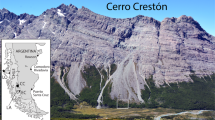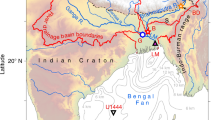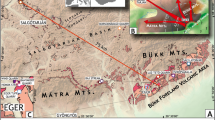Abstract
THE Cascadia subduction zone, which extends along the northern Pacific coast of North America, might produce earthquakes of magnitude 8 or 9 ('great' earthquakes) even though it has not done so during the past 200 years of European observation1–7. Much of the evidence for past Cascadia earthquakes comes from former meadows and forests that became tidal mudflats owing to abrupt tectonic subsidence in the past 5,000 years2,3,6,7. If due to a great earthquake, such subsidence should have extended along more than 100 km of the coast2. Here we investigate the extent of coastal subsidence that might have been caused by a single earthquake, through high-precision radiocarbon dating of coastal trees that abruptly subsided into the intertidal zone. The ages leave the great-earthquake hypothesis intact by limiting to a few decades the discordance, if any, in the most recent subsidence of two areas 55 km apart along the Washington coast. This subsidence probably occurred about 300 years ago.
This is a preview of subscription content, access via your institution
Access options
Subscribe to this journal
Receive 51 print issues and online access
$199.00 per year
only $3.90 per issue
Buy this article
- Purchase on Springer Link
- Instant access to full article PDF
Prices may be subject to local taxes which are calculated during checkout
Similar content being viewed by others
References
Heaton, T. H. & Hartzell, S. H. Science 236, 162–168 (1987).
Atwater, B. F. Science 236, 942–944 (1987).
Darienzo, M. E. & Peterson, C. D. Tectonics 9, 1–22 (1990).
Adams, J. Tectonics 9, 569–583 (1990).
Savage, J. C. & Lisowski, M. Science 252, 101–103 (1991).
Atwater, B. F. & Yamaguchi, D. K. Geology 19, 706–709 (1991).
Atwater, B. F. J. geophys. Res. (in the press).
Plafker, G. J. geophys. Res. 77, 901–925 (1972).
Ando, M. Tectonophysics 27, 119–140 (1975).
Kanamori, H. J. geophys. Res. 82, 2981–2987 (1977).
Wyss, M. Geology 7, 336–340 (1979).
Sieh, K., Stuiver, M. & Brillinger, D. J. geophys. Res. 94, 603–623 (1989).
Scott, E. M., Aitchison, T. C., Harkness, D. D., Cook, G. T. & Baxter, M. S. Radiocarbon 32, 309–319 (1990).
Stuiver, M. & Becker, B. Radiocarbon 28, 863–910 (1986).
Stuiver, M. & Pearson, G. W. Radiocarbon 28, 805–838 (1986).
Cooper, J. G. in Reports of Explorations and Surveys to Ascertain the Most Practicable and Economical Route for a Railroad from the Mississippi River to the Pacific Ocean, Vol. XII, Book II 36th Congress Exec. Doc. 56 (House of Representatives, 1860).
Cowan, D. W. & Potter, C. J. (compilers) Geol. Soc. Am. Continental-Ocean Transect B3 (1986).
Stuiver, M., Burk, R. L. & Quay, P. D. J. geophys. Res. 89, 11731–11748 (1984).
Author information
Authors and Affiliations
Rights and permissions
About this article
Cite this article
Atwater, B., Stuiver, M. & Yamaguchi, D. Radiocarbon test of earthquake magnitude at the Cascadia subduction zone. Nature 353, 156–158 (1991). https://doi.org/10.1038/353156a0
Received:
Accepted:
Issue Date:
DOI: https://doi.org/10.1038/353156a0
Comments
By submitting a comment you agree to abide by our Terms and Community Guidelines. If you find something abusive or that does not comply with our terms or guidelines please flag it as inappropriate.



